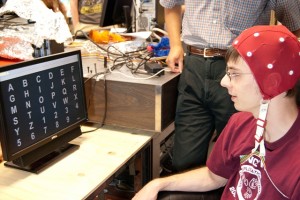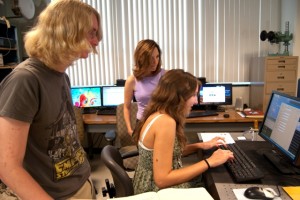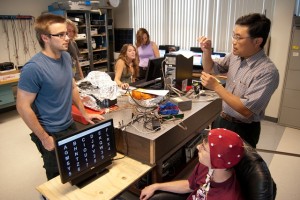
David Salter ’12 demonstrates how the brain-computer interface works.
A group of students and faculty are spending their summer playing mind games.
In an interdisciplinary project that brings together neuroscience and electrical and computer engineering, the research group is working on technology that will allow users to control a computer application using only their own brainwaves.
“It’s awesome being able to do something extraordinary with your mind, especially when minds weren’t really meant to be trained like this,” says Tony Lorence ’13 (Cumbola, Pa.), an electrical and computer engineering major. “The patterns of brainwaves we are recording were just signals that appeared simply because of regular brain usage. But once we found them, we were able to train ourselves (and the machine learning from the software) how to perform better at a given task.”
The team also includes neuroscience majors Christopher Angeloni ’12 (Sykesville, Md.) and Victoria Corbit ’13 (Reading, Pa.) and electrical and computer engineering major David Salter ’12 (Bethlehem, Pa.). Yih-Choung Yu, associate professor of electrical and computer engineering, and Lisa Gabel, assistant professor of psychology, are their faculty mentors. The project is funded through a faculty innovation grant from the Office of the Provost.

Anthony Lorence ’13, Lisa Gabel, assistant professor of psychology, and Victoria Corbit ’13 analyze the data.
The field of brain-computer interface (BCI) technology has the potential to treat neurological diseases such as ALS, stroke, and paralysis, and improve the lives of people who have such conditions.
The team is creating a memory card game, the type where players lift up cards, two at a time, from a grid of face-down cards, trying to match the paired cards together. The difference from the simple children’s version is that this one is virtual and controlled directly by thought.
Potentially, a memory game like this could be used to help train patients to use other BCI communication technology.
“Getting to work on a project in such an emerging field has been fascinating because we’re doing things that seem impossible to those not in the field. Before I knew about brain-computer interface, I never would’ve thought someone could write using brain waves,” says Corbit.
As part of their research, the group visited the Wadsworth Center in Albany, N.Y., one of the world’s leading research facilities in the field of brain-computer interface.

Christopher Angeloni ’12, left, speaks with Yih-Choung Yu, associate professor of electrical and computer engineering.
The group learned about various BCI systems that the Wadsworth Center has developed, from simple up-down cursor movement, to playing the video game Doom, to selecting targets in a 3D environment. In all of these activities, the person controlling the game doesn’t use a controller or joystick—only their own thoughts.
Before their visit to the Wadsworth Center, the team was planning on a different technique of BCI for their project. However, that would have required months of training.
“Our trip showed us that we could use a different BCI technique and have our participants spelling within a day. Seeing that really rejuvenated our project and sent us in a whole different direction than [where] we previously thought we were headed,” Corbit says.
The visit to the center also helped the students see the gap between the amazing technological capacity that is possible with BCI and its affordability and accessibility. The average patient who might benefit from BCI is often unable to afford the high cost of the technology.
“Most popular science media sources describe BCI technology that is cutting edge but don’t emphasize that this kind of technology is not only incredibly expensive, but can only be used invasively through brain surgery,” says Angeloni. “Most of the devices that get attention are the ones that need to be inserted underneath the skull, but while they can do really neat things, they aren’t a very realistic option for neurological treatment. The Wadsworth Center is working on bridging this gap by producing affordable and relatively easy to use BCI systems that can be installed in the homes of those who need them.”
The goal of this summer’s BCI project is to provide a starting point for future research at Lafayette.
“We all came in with no specific experience in BCI and had to figure out how to get unfamiliar equipment and programs to work together. Our work will hopefully be just a launching point for later Lafayette students to come in and start doing their own research,” says Salter.
“The most rewarding aspect has been working with other disciplines than my own. As a neuroscience and art double major I’ve never really been able to work with engineers, but working on this project has allowed me to work with several electrical engineers, and it has been very fulfilling,” says Angeloni.



2 Comments
Comments are closed.